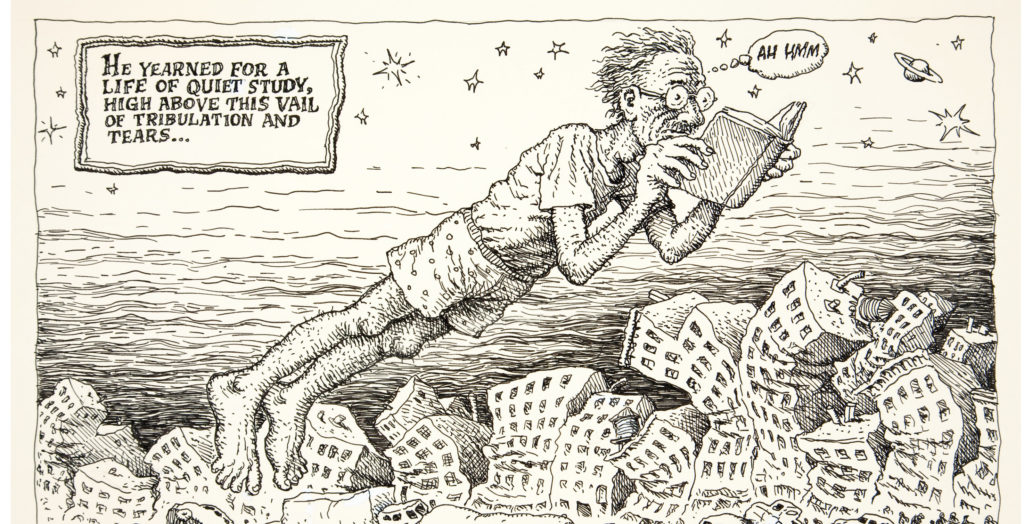The artwork of Robert Crumb has been a source of fascination for many. His artwork from the 1960s and early ’70s has been especially interesting, to the point that sales of some of his more iconic pieces have made the news a number of times in recent years, for the incredible amounts of money some are willing to spend to own it.
Buy, Value or Appraise Your Comics
Bid or buy comic books and illustrations for sale, value your item, or request a free appraisal to sell your collection.
In the 14-plus years I have worked in Heritage’s Comic Division, I have handled a lot of R. Crumb artwork. All of it – even the stuff that some would consider extremely vulgar or offensive (Crumb has been notorious for holding nothing back) – has been interesting.
Yet for me, nothing has been like the experience of leafing through one of his sketchbooks from that halcyon period of 1967-71, his peak years as an Underground Cartoonist. This 1970-era sketchbook , which had 20 bidders before realizing at $143,400 in Heritage Auctions’ Nov. 16-18 Comics and Comic Art Auction is, to use a 1960s phrase, “mind-blowing.” Let me try to explain why.
Robert Crumb was the second of five siblings in his family. His older brother, Charles, was an avid comic book reader, and his love of late 1940s-early 1950s comics devoted to such kiddie fare as Little Lulu and Donald Duck rubbed off on Robert. Growing up, the siblings all were coerced by Charles to create their own line of homemade comic books, drawn in pencil on folded sheets of lined notebook paper. It didn’t take long for Robert’s younger brother and sisters to lose interest, but Bob and Chuck carried on, creating their own storylines based on characters from a favorite movie, Treasure Island. In their teen years, a time when most kids their age regarded comic books as foolish and juvenile, the Crumb brothers were considered geeky outcasts by their classmates.
Eventually, Charles, in his attempt to “fit in” with the others, lost interest. Not Robert. He kept up his obsession of drawing every day, filling composition books with doodles and comic stories. This became a lifelong habit.
Robert’s ever-improving talent landed him his first job as a professional artist, working for the American Greeting Company in Cleveland. It was here that Robert mastered the use of the Rapidograph mechanical pen. These pens require meticulous maintenance (they clog up easily), but produce smooth, print-ready lines of ink. It was while at American Greetings that someone handed Robert a blank bookbinder’s sample hardback; Robert filled it with inked drawings, and kept on, sketchbook after sketchbook. After moving to San Francisco in 1967, Robert’s drawings became a hit with the hippie set and his career as an Underground Comix artist bloomed.
It was living in California that Robert acquired another sample hardback book, one printed with cover art for a children’s book, but all blank pages. It was 1970, and Robert, still the obsessive doodler, filled each page with his intricate drawings of people and objects around him, ideas for comic characters, and wild images from his unleashed imagination.
Lots of people like to doodle on scraps of paper during idle moments, but it takes a real drive to produce something like this book. I know, as I too have filled sketchbooks with my own artwork for years. It’s not easy to do this on a daily basis, and I often have gone through long dry periods without picking up a sketchbook. I don’t know how he kept it up, but Crumb’s artistic talent and compulsion to draw must have had something to do with it.
I had the pleasure of meeting Robert Crumb in 1984, at a Dallas Comic Convention, where he and several other well-known Underground cartoonists were guests. Having been a longtime fan of the “jam” pages in Zap Comix (pages passed from one artist to another, with wild, off-the-wall results), I had the audacity to start up a page and ask these well-known artists to contribute. Amazingly, Crumb agreed to participate. (The resulting page, “Oh No! Comics” can be found in the Heritage archives). I guess we hit it off, because Crumb asked me to drive him around Dallas the day after the con, in search of old 78 blues records he collects. When I went to his hotel to pick him up, I found him sitting in the lobby, doing something in his then-current sketchbook. He got up to go check out, and handed me the book to look through while I waited. It was an unusual thrill, to say the least.
That thrill came back to me as I leafed through this 1970 book, writing the description for the auction catalog. The lucky bidder winning this awesome prize no doubt will have a similar thrill, despite the significant cost. Robert Crumb is one of the most important artists in the past 50 years, and I’d rather look at his art that any of the high-priced “Fine Art Masters” that fill galleries today.
What does Robert Crumb think about all this? He said it many years ago: “It’s just lines on paper.” But oh, what lines they are!
Written by: David Tosh
